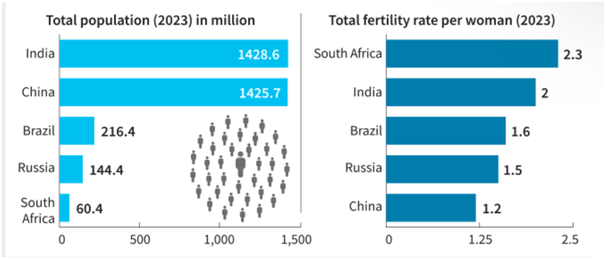India- Highest Populated Country in the world
Context: India is set to overtake China to become the world’s most populous country by the middle of 2023, according to data released by the United Nations.
More on the news
- India’s population is pegged to reach 142.86 crore against China’s 142.57 crore. This shows India will have 29 lakh more people than its Asian neighbour.
- The United States is a distant third, with an estimated population of 34 crore, the data by the State of World Population Report, 2023 of the UN Population Fund (UNFPA) showed. The world’s population hit the 800-crore mark in November 2022.
- The report says that contrary to the alarm bells about exploding numbers, population trends everywhere point to slower growth and ageing societies.
- Just eight countries will account for half the projected growth in global population by 2050 — the Democratic Republic of Congo, Egypt, Ethiopia, India, Nigeria, Pakistan, the Philippines and the United Republic of Tanzania — while two-thirds of people now live in a country where lifetime fertility corresponds with zero growth.
- At a time when there have been increasing calls for imposing a two-child norm in India by various political leaders, and some States such as Assam have issued an order in 2021 to bar those with more than two children from government jobs, the UN agency said its findings for India too had suggested that “population anxieties have seeped into large portions of the general public”.
- It called for a radical rethink on how countries address changing demographies and cautioned against use of family planning as a tool for achieving fertility targets.
Gender based Discrimination
- Global experience showed that family planning targets can lead to gender-based discrimination and harmful practices such as prenatal sex determination leading to sex-selective abortion.
- Imposition of such targets can lead to imbalanced sex ratios, preferential health and nutrition for male children, denial of the paternity of girl children, violence against women for giving birth to girl children, and coercion of women to have fewer or greater numbers of children.
- With close to 50% of its population below the age of 25, India has a time-bound opportunity to benefit from the demographic dividend,” and that it must convert this into “economic benefits through additional investments in health, education, and quality jobs for young people — including targeted investments in women and girls.
| Practice Question
1. Do you think the world needs re-evaluation of population policy? Justify your opinion. |




